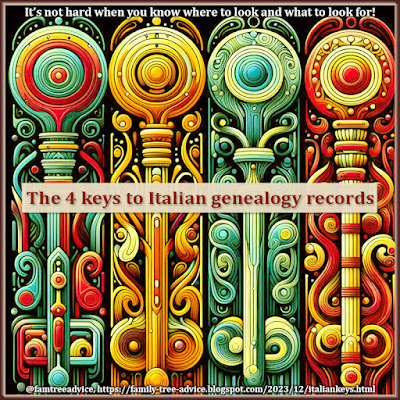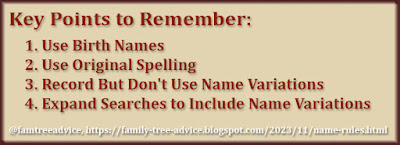I don't worry too much when two documents' facts disagree with one another. That's because I can apply these 5 tips to overcome the discrepancies. And so can you!
 |
| When genealogy documents disagree, these 5 tips help you figure out what's wrong and what belongs in your family tree. |
1. Gather as Many Documents as Possible
Imagine you're piecing together a family from their town's vital records. You notice the husband seems an awful lot older than his wife when one of their kids was born. How can you find out if his stated age is reliable? The answer is more documents.
Search for all the children and check his stated age on their birth records. If only one record has the unlikely age, then that record is in error.
For an in-depth example, read "When Documents Disagree, Get More Documents."
2. Trust Earlier Documents More
I spend most of my research time in the 1800s. People back then didn't have to fill out forms all the time like we do today. Many of them couldn't even write their own name. So it's completely understandable that they may not have known their birth date.
If a woman gets 10 years younger when her fifth child is born, it's because no one knows her age. The town clerk writing the birth record asked the husband how old his wife is. Do you think he really knows?
He's far more likely to know his wife's age when their first child is born. By the time the last child is born, he hasn't got a clue. That's why it's safer to believe the earliest document to mention her age.
3. Expect Some Human Error
Italian marriages in the mid-1800s generated a lot of documents. These include rewritten copies of the bride and groom's birth records. But sometimes they're the wrong record. It's most likely a human error on the part of the town clerk.
In nine errors out of 10, the clerk included the birth record of an older sibling with the same name who died as a baby. Last week I found an 1840 marriage that included a birth record for the wrong man entirely. He had the right name, but he came from a different family!
You can imagine how the clerk's error could mess up a lot of people's family trees. That's why you need to document the bride and groom's entire families. You'll know the baby born on such-and-such a date died a year later. Then you can assume it's the next child with the same name who's getting married.
To learn how to use Italian marriage documents, read "The Italian Genealogy Goldmine: 'Wedding Packets'."
4. Understand Name Usage and Evolution
It's not uncommon for a person to use their middle name rather than their first name. It's also not uncommon for the spelling of a last name to change over time.
I've seen countless babies born with multiple names who go by only one of those names. Maria Teresa uses the name Teresa. Nicola Antonio goes by Antonio. You must stay open to these possibilities. Don't rule out a document because you know he was born Nicola Antonio and this record says Antonio. Look at the big picture. What other facts can help you confirm that Antonio is really Nicola Antonio?
The spelling of a last name can evolve or change completely. My grandmother and her siblings had the last name Sarracino. Somehow the whole family lost an R and became Saracino by 1940. Some names lose their prefix over time. For instance, the name diRuccia became Ruccia. And it's common for people to make their name less ethnic in their adopted country. (It didn't happen at Ellis Island!)
When you see a last name change, look at the first names and ages. Are they the same as the family with a somewhat different last name? That's a handy tip when you find a bad transcription or a last name written incorrectly on a document.
5. Know Which Documents Are More Reliable
Because I spend countless hours viewing vital records, I've noticed trends. Many of my ancestral hometowns provide access to death records from 1931–1942. I've found that the deceased's age on these records is highly reliable. I'll bet that that during this time a clerk verified the person's age instead of taking somebody's word for it.
I've also found that a bride and groom's age on their marriage document is quite reliable. That comes in handy if you don't have access to their birth records. The reasons for this improved accuracy may be:
- They're still young enough not to have forgotten how old they are.
- Even if we don't see the documents, the town checked their birth records before performing the marriage.
In more recent times, I've seen a variety of names applied to myself. After 2 marriages, I've had 3 last names, and they're all misspelled constantly. I get mail with 2 different middle initials, and I have no middle name! Then there's my first name with its made-up spelling. My entire name is rarely spelled the right way.
If a genealogist is trying to research me in the distant future, good luck to them! It's going to take a whole lot of documents to make sense of my name alone.
Put these 5 tips to use and keep them in mind when you're researching your family tree.





